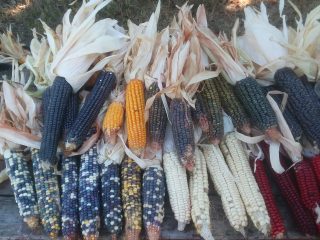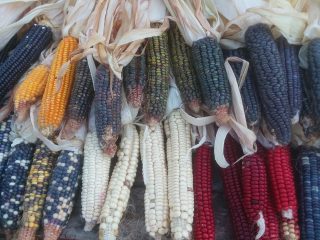I
Miedo y duda
Confianza y comodidad
Washing over one another.
Cuando estoy con Usted,
Madre Maíz,
no tengo demaciada duda.
En esta manera está como mi madre,
Reaseguándome
Calmándome
Sus olas de calma me limpia,
Lap at my adolescent discomfort
Help me feel comfortable in my skin.
But now that you’ve returned to the ground for the season
I’m lost again.
No wonder the wise ones who have walked with you forever braid you and hang you as a beloved in their homes.
I hold your babies dear while the waves crash.
Olas de duda:
Is it OK for me to be doing this?
Am I “allowed” to grow the corn?
Should I be giving it to other white people who will grow more?
Does it want to be grown on a larger scale?
Is it OK that some of it will go to a white-owned upscale taquería?
Olas de confianza:
Crecer el maíz es entender más cómo vivir.
Su sabiduría es una guía, y estoy escuchando.
Estoy escuchando.
I asked your permission
And you gave it
Conditionally;
You see that I am a child.
I moved too fast at some points,
Forgot to ask at others
But I am listening
Learning
The olas swirl together around me,
Duda y confianza
It is OK.
It is OK to try.
I will devote my life to learning your lessons,
Madre Maíz
Organize around you
Sow your seeds each spring
Care for you each summer
Ask your permission to harvest each fall
Eat from your gracious sustenance each winter
And it is OK if I do not learn all I need to know to earn your trust
As a keeper of the corn
And your sacred pact with humanity.
One lifetime is not a long time
Compared with millennia.
You do not owe me anything.
I am grateful for all you have given to me and to the família humana
In a few short years you have touched my life in ways too deep to speak.
Thank you for your permission to try.
II
 At no other time have I connected myself so thoroughly to the fact that I am an immigrant as in growing this corn. I could put a pinpoint on the place I am native to, literally living more than 30 of my years on the same street, in the same town. And yet I’m an immigrant in it, my own lines broken by adoption and immigration to the point that I don’t know from where I came. I am a relative newcomer to a continent where people who look like me rained devastation on people who were here, those who co-created the corn, with an army of smallpox and greed. In a civilization built on corn but ignorant of it, and ignorant of the provenance of most of the basics of survival, do I belong or not? But if not here, then where? And if here, then what? Through this lens, the most logical thing to do is to grow the corn, to learn how to grow it and how to eat it and to incorporate it into my life in ever-greater ways. And to share what I am learning with others who yearn for the nourishment, connection, and insight she provides, while holding the truth of imperialism and the intersections of privilege and power, class and race in the forefront of my mind.
At no other time have I connected myself so thoroughly to the fact that I am an immigrant as in growing this corn. I could put a pinpoint on the place I am native to, literally living more than 30 of my years on the same street, in the same town. And yet I’m an immigrant in it, my own lines broken by adoption and immigration to the point that I don’t know from where I came. I am a relative newcomer to a continent where people who look like me rained devastation on people who were here, those who co-created the corn, with an army of smallpox and greed. In a civilization built on corn but ignorant of it, and ignorant of the provenance of most of the basics of survival, do I belong or not? But if not here, then where? And if here, then what? Through this lens, the most logical thing to do is to grow the corn, to learn how to grow it and how to eat it and to incorporate it into my life in ever-greater ways. And to share what I am learning with others who yearn for the nourishment, connection, and insight she provides, while holding the truth of imperialism and the intersections of privilege and power, class and race in the forefront of my mind.
III
She is stunning,
An architectural masterpiece
Stately gorgeous
Leaves spiraling in perfect symmetry to
Soak up the sun
Human-like
Or what we would like to be
Her womb like an outstretched hand
Closed tightly to protect
Her sacred jewels
Sturdy cob cradling them safe
Sheathed in soft leaves
While they ripen
Yes pollen you can enter
But only one grain at a time
And she keeps the gate
She is generous
Babies ringing her hand in
Spiral rows of stunning sustenance
She gifts them to humanity
Gave up her ability to survive on her own in a sacred pact
We live by her generosity.
IV
The intersectionality of food is on my mind. As a white woman in Idaho growing Indian corns partly to see a rainbow of tortillas made by a Mexican-American chef in a white-owned upscale taquería, how can it not? I am not interested in usurping or appropriating anyone’s culture. I just want to eat good tortillas. I also want to learn to grow some staple grains on my farm and incorporate them into my diet. Corn has proven to me, like it has for so many other civilizations, that it is the best choice for small-scale hand cultivation, harvest, and processing. It grows tall while reaching for the sun so it can out-compete weeds. It can be grown, as it has co-evolved with humans for millennia, in a milpa, a combination of crops who work together to create a more ecological form of agriculture that has kept certain pieces of land in Mesoamerica in continuous production for centuries.
 The problems with modern-day agriculture abound, and as with anything, it’s good to be able to name the problems. With regard to intersectionality, this country is built on the backs and sweat of poor people. Poor people throughout this continent have been considered useful in the building of empires of roads and farms and buildings for the rich, before and after the arrival of my white ancestors. Not in all cultures is this true, but certainly in many and certainly in the one that became dominant after my white ancestors took the reins in this country.
The problems with modern-day agriculture abound, and as with anything, it’s good to be able to name the problems. With regard to intersectionality, this country is built on the backs and sweat of poor people. Poor people throughout this continent have been considered useful in the building of empires of roads and farms and buildings for the rich, before and after the arrival of my white ancestors. Not in all cultures is this true, but certainly in many and certainly in the one that became dominant after my white ancestors took the reins in this country.
In modern times we’ve taken one of the sacred foods of the people who co-created it and turned it into vast industrial monocultures sprayed with chemicals and fertilizers and processed to feed the industrial machine of diet sodas and cheap hamburgers. And we subsidize it with our tax money. So when NAFTA went into effect, the US could sell our cheap, subsidized corn to Mexico cheaper than Mexican farmers could, which drove them out of business and send them scrambling north, like moths to the flame, into the belly of the beast that destroyed their communities.
And in the succubus sponge of capitalism, the rich slurp up all the wealth and the ground is drying out on the bottom. So poor people are turning against each other, blaming Mexicans for taking our jobs, telling immigrants to get out. It sucks that there aren’t more Latino farmers in our area. It sucks that I am able to own my own farm, if not the land I farm on, while most farmhands and migrant farmworkers are Latinos.
So you want to grow the corn, White Girl? You want to sell it to a white-owned taquería? Yes, because they’re willing to pay farmers a living wage to grow food. Because they want local farmers to exist and they want to eat and serve what can be grown here. Is that a privilege? Yes. Is it also true that people expect food to be cheap? Yes. Even moreso that ethnic food should be cheap? Yes. I remember reading this great article by a Vietnamese chef who was complaining that she wanted to have an upscale Vietnamese restaurant but folks complained that it was “too expensive for Vietnamese food.” It is fucked up that white folks can open Mexican restaurants with fancy Mescal bars and get away with charging a price for a meal that allows them to actually afford to pay local farmers to grow food on a smaller, more sustainable scale while forces of segregation make that less plausible for a Latino restaurateur, not to mention that that model doesn’t speak to everyone.
In a related question, Who wants this corn? Partly I want to give it to them because they asked. They love it–both the corn and the agriculture–enough to ask for it. When we talk about cultural appropriation in food, I’d say 99% of people have the same response: Who cares? Who cares about corn, or tortillas, or agriculture, really? People all fired up about injustice slurp down sodas and coffee…Taco Bell or McDonalds? Is there really a difference? We all live and die by an oppressive system. So for me, growing the corn and seeing it made into tortillas in my own community is an act of liberation, a hopeful sustenance, a prayer for a more sane and sensible world founded on things that matter: environmental health and sustainability, an equitable distribution of wealth and power, and an honoring of the producers in a society.
V
If we mistreat her, she will kill us
Marching her into monoculture rows like soldiers
Decimated farmland
Poisoned oceans
Obese humans dying of heart disease
She offers a welcome and a warning
What we do to her, we do to ourselves.

